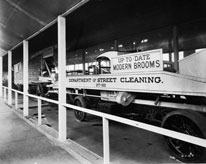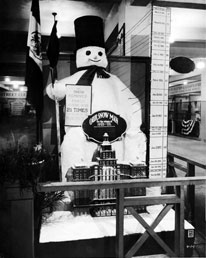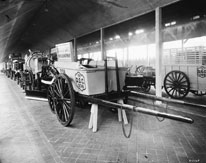Exhibition: A Pictorial Review, Greater New York's Silver Jubilee, May 26-June 23, 1923
A Digital Initiatives Department Exhibit, B. Davis Schwartz Memorial Library, February 14-March 20, 2011.
- Documentation of the Exhibit
- Jubilee
- Education
- NYC Fire Department
- NYC Police Department
- NYC Street Cleaning
New York City Department of Street Cleaning

Up-to-date modern motor brooms specially adapted for cleaning the 5 large East River bridges of snow (wrh_pr2_82.tif)
Alfred A. Taylor was appointed Commissioner of Street Cleaning by Mayor John F. Hylan in 1921, after more than 20 years of service to the department. The Department of Street Cleaning Exhibit, directed by John J. Condon, Superintendent of Snow Removal, was located on the fourth floor of the Grand Central Palace. The exhibit demonstrated the dramatic changes in the department that took place between 1898 and 1923. It contained models of new incinerators, sea dumpers, vehicles, equipment, and organizational and statistical charts that showed the development of the department overtime. As part of the exposition, an Attractoscope, a device to project glass slides, was used to continuously show 50 various phases of street cleaning work.
Most astonishing was how antiquated methods of garbage collection and street cleaning were rapidly being replaced by motorized equipment. Ashes and rubbish were disposed of in landfills and garbage was disposed of at sea, dumped at a distance of about 40 miles from the Battery. Progress was in part driven by population growth. For example, the collective population of Manhattan, Brooklyn and the Bronx grew from 3,245,930 in 1898 to close to 6,000,000 in 1923. Charts displayed at the exhibit indicated that the garbage collected in Greater New York in 1922 equaled the amount of the combined collections of seven of the largest cities in the United States.

Model of a Snow Man, showing the volume of snow removed from 1,000 miles of New York City streets scheduled for snow clearing. (wrh_pr2_069.tif)
A model at the exhibit nicknamed New York's Snow Man held a record of statistics for the amount of snowfall removed totaling 55.1 inches in the bleak winter season, 1922-1923. Record breaking snow amounts that accumulated during that winter were combated by the department's latest powerful motorized trucks, snow plows attached to the modern ash removal carts, tractors and mechanical snow loaders. Mounds of snow were disposed of at sewer manholes and waterfront dumps. In late December of 1922, despite motorized equipment, Commissioner Taylor placed an advertisement for extra snow removal workers and raised the rate of pay from 45 to 50 cents an hour.
This year in New York City, with snow accumulations calculated at 57.7 inches as of February 2nd, the New York City Department of Sanitation (DSNY) under Commissioner John J. Doherty took some drastic measures. Alternate side parking regulations were suspended citywide to facilitate snow removal and the payment at parking meters was suspended throughout the City until February 7th. The New York City Department of Sanitation also called for additional commercial heavy duty equipment to assist in the removal of snow and ice from the City streets resulting from this year's continuous major snow storms.

Old style horse drawn cart and paper truck (wrh_pr2_078.tif)
In 1923, new members of the expanding department spent approximately two weeks in formal training. Candidates were instructed in hitching, driving, and caring for the horses that pulled rubbish carts, lifting metal ash cans and the correct method of street sweeping and hose flushing. Still others were trained in driving motorized equipment and road work. The department also maintained its own mechanical bureau and repair shops, one in each borough, to make all the repairs on horse drawn and motor equipment. Today, joining the workforce is much more difficult when compared to the requirements 88 years ago. Potential workers must pass a written exam and a physical test. In addition, each candidate must have a high school diploma, or equivalent, and a commercial driver's license at the time of appointment.
At the time of the consolidation of Greater New York in 1898, street cleaners worked 10 hours per day, and more during emergencies. The average street sweeper made $660.00 per year. By 1923, as the force grew from 3,299 to 6,582 men, the average wage increased to $1,586.00 per year. Overtime pay at the rate of time and a half was also introduced. The starting salary of a sanitation worker today is $31,200 per year. Their labor agreement provides for periodic increases to a maximum of $67,141 after 5 1/2 years. In addition to the basic annual wages, sanitation workers may also earn differential payments based on their specific assignment and overtime.
